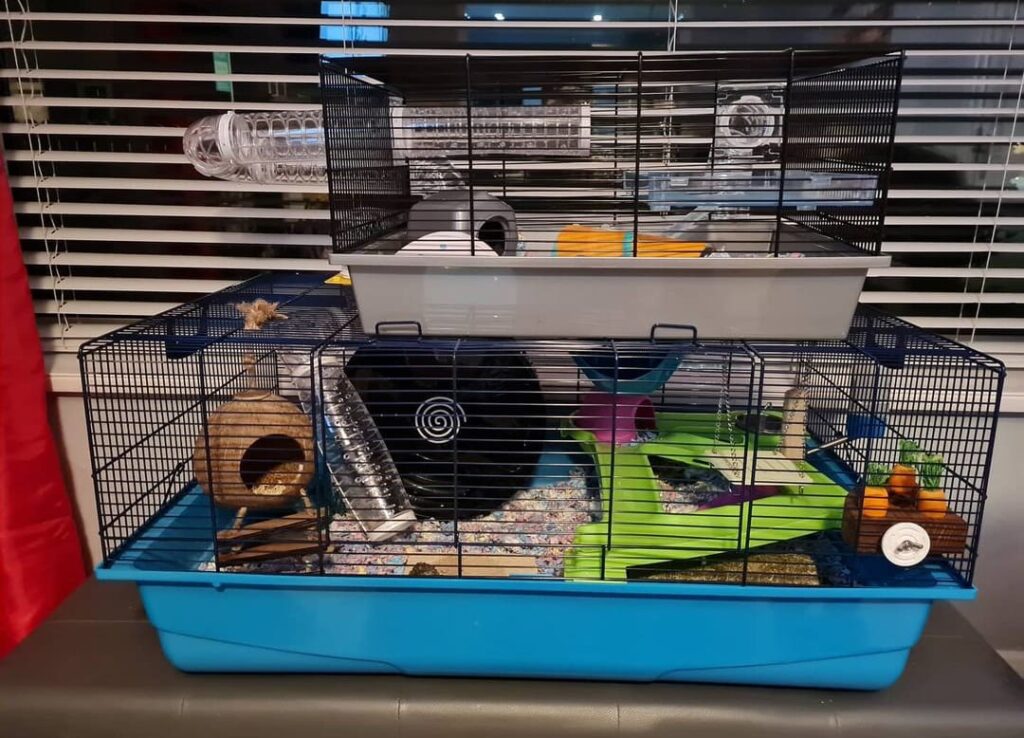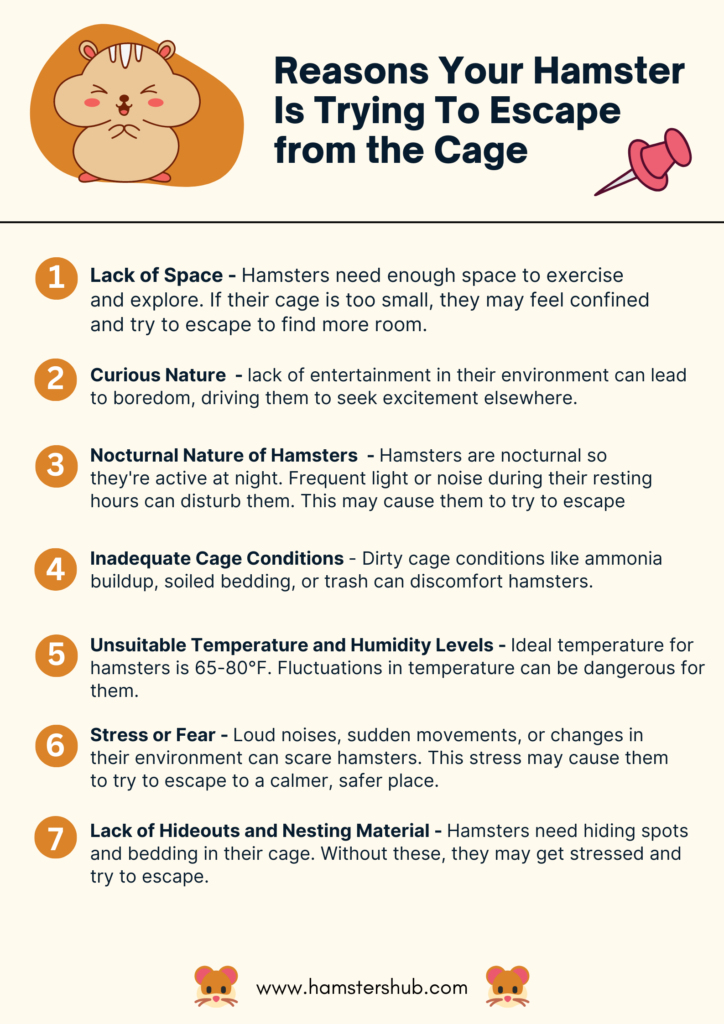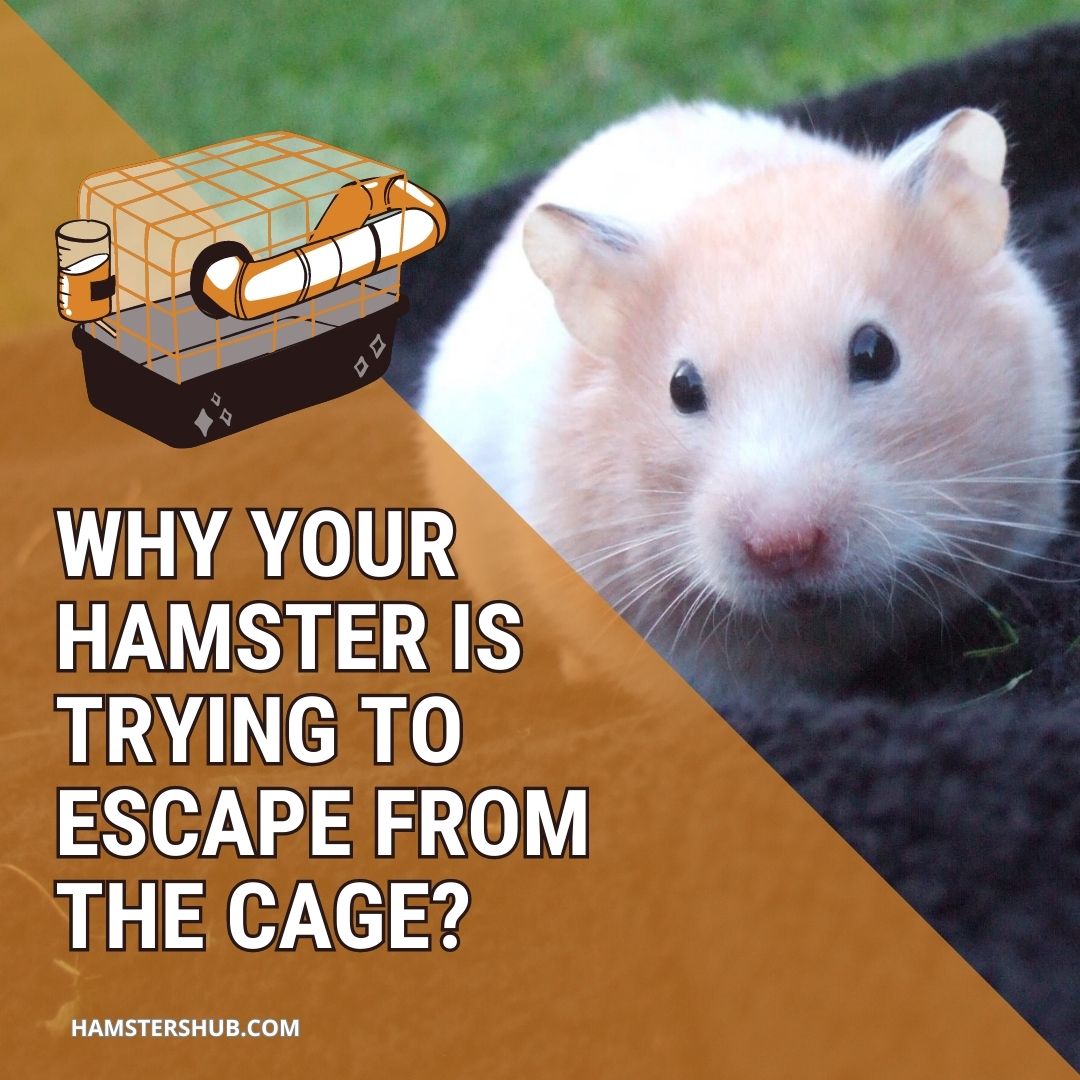Hamsters are really good at escaping. They can squeeze through tiny spaces that seem smaller than their actual size. They have strong teeth and can chew through wood and certain materials. They can even use their teeth and paws to open cage doors.
Have your hamster tried to escape the cage? Well! That’s not new! They often attempt to escape the cage. But, no need to be worried. While prevention is the best solution to avoid escapes, if you have hamsters for a long time, it’s likely that you will eventually have to deal with an escape.
Let’s dive right in to discover types of escape and the reasons why hamsters try escaping. This guide also helps you to explore what to do to avoid it. You can easily take precautions to safeguard your furry friend by understanding these. Read on!
7 Reasons Why Your Hamster Is Trying to Escape from the Cage!
Here are some very common reasons that can be the cause of your beloved furry friends escaping. So, buckle up, and let’s delve in!
1. Lack of Space
First and foremost, hamsters’ cages need to be of a certain size. These lovey-dovey creatures require sufficient space to exercise and explore. If their cage is too small, they may feel bound and attempt to flee in search of greater space.

For example, Siberian and other little breeds of hamsters do better in smaller spaces compared to Syrians. But it is usually recommended to have a larger cage for hamsters, irrespective of their size.
Solution:
Ensure that your hamster cage is of adequate size. According to Pet MD, the height of the cage should be 24 inches, and it should cover at least 900 square inches of floor space. Because the hamster may squeeze through the cage wires, the spacing between them is critical. If they have the ability to get their heads through, they should be able to get their bodies through as well.
For Syrian hamsters, the wire size should be 1 cm or smaller; for smaller breeds, the space should be much less. Moreover, consider providing extra playtime outside the cage as well.
2. Curious Nature
Hamsters are intelligent animals that require mental stimulation for them to survive. They are curious about everything that happens and may stick their head out to check what you are doing. Therefore, a lack of entertainment in their environment can lead to boredom, driving them to seek excitement elsewhere.
Solution:
To keep your hamster interested and mentally stimulated, provide a variety of toys, tunnels, and chewable things in the cage. Particularly, make sure your hamster gets enough activity. That means he’ll need a hamster wheel to run in.
Smaller breeds like Siberian or Campbell can get by with smaller wheels, such as 15-18 cm. However, the minimal diameter wheel for Syrian hamsters is 23 cm.
3. Nocturnal Nature of Hamsters
Hamsters are nocturnal creatures, which means they are most active at night. They may become disturbed and attempt to flee if they are kept in a location with frequent light during their natural resting hours. If Their cage is placed in a child’s room that is typically noisy, it can disturb their sleep as well. Thus, leading them to escape and find a calmer place.
Solution:
Locate the hamster’s cage in a calm and dimly lighted area to provide an ideal environment for relaxation. Because even the slightest noise can set off their predatory instincts, they require hiding areas to feel comfortable and safe.
Since hamsters sleep for most of the day, it’s important to place their cage in an area where they can rest undisturbed. In many families, hamsters are considered pets for children, so they often end up in the child’s bedroom.
But, children usually cannot take care of pets as elders do. So, if you have an extra bedroom available, it would be a suitable place to place the hamster’s cage.
Alternatively, you can place the cage in an adult’s bedroom if you have enough space.
4. Inadequate Cage Conditions
Just like humans, housing conditions that are unclean or unsanitary can cause them discomfort. Such as ammonia buildup from urine, unclean bedding, or trash accumulation can make their living conditions unpleasant.

The unclean environment increases the risk of respiratory infections and the build-up of pathogens. These pathogens could be bacteria, fungi, or viruses such as salmonella, Ringworm, etc, which could further be transmitted to humans as well.
Solution:
Regular cage cleaning is necessary to maintain optimum hygiene and prevent odors that can tempt your hamster to flee. To avoid health issues caused by spoiled food, it is important to remove any leftover fresh food, like fruits or vegetables, from the hamster’s cage after one day.
Once a week, you should replace all the bedding in the cage, except for the hamster’s nest and food hoard. Leaving these items undisturbed helps the hamster feel clean, safer, and more secure.
However, if the hamster has scattered waste throughout the cage, replacing all the bedding during the weekly cleaning is recommended.
5. Unsuitable Temperature and Humidity Levels
Similar to other pets, hamsters are sensitive to severe temperatures and humidity levels. If your hamster’s cage becomes too hot, humid, or damp, he or she may attempt to flee in search of a more comfortable environment.
For hamsters, the optimum temperature to survive is 18 – 20 ͒ C (65 to 80 degrees Fahrenheit). Therefore, taking care of the temperature level is important because any fluctuation might prove fatal for them.
Solution:
Place the cage in a well-ventilated area away from direct sunlight and regions prone to excess dampness. It’s important to keep your hamster’s cage indoors in a room where the temperature is regulated.
Avoid placing the cage in places like the garage, screened patio, or basement. Even if your basement has a heating system, it may still be cool in the summer.
You probably don’t run the heater in the basement during that time, right? What might feel pleasantly cool to humans (around the mid-60s Fahrenheit) on a warm day is actually too cold for hamsters.
Low temperatures can cause them to go into hibernation.
6. Stress or Fear
Hamsters are sensitive animals, and some factors may cause stress or fear in them. Escape behavior can be triggered by loud noises, unexpected movements, or disturbances in their surroundings.
So, they are seeking a calmer and safer environment. A frightened hamster experiences stress, which is not good for its well-being and may be the cause of its escape.
Solution:
Keep an eye on your hamster for a few days and see what continues to frighten him. It may be anything: children, lawnmowers, even visiting relatives. Look for symptoms of stressed hamsters and changes in behavior like aggressiveness, agitation, restlessness, or excessive hiding.
If you notice any of these frequently, determine the cause and look for a solution to keep your beloved pet safe.
It’s crucial to understand that no matter how secure you believe your hamster’s cage is, you should not keep these small creatures with other pets. Cats, in particular, are skilled climbers and can find ways to access their prey.
Additionally, even their mere presence, sight, and scent can cause fear in your hamster.
7. Lack of Hideouts and Nesting Material
Hamsters are burrowing animals that require hiding spots and nesting material to feel secure. If their cage lacks appropriate hiding places or soft bedding material, they may become stressed and attempt to escape.
Solution:
Provide your hamster with tunnels, boxes, and suitable bedding to create a cozy and secure environment. You can provide some items that make good materials for your hamster to build its sleeping area. These materials can be used along with the bedding in the cage. Here are some examples:
- Paper towel
- White, unscented toilet paper
- Cardboard tubes from paper towels or toilet paper: These tubes can be a special treat for your hamster, especially if you leave a sheet or two of the paper attached. Hamsters love crawling through these tubes and can be used as toys.
- Other light cardboard, like empty tissue boxes
These cardboard boxes can serve as climbing structures or hiding places for your hamster. Providing these simple materials can help your hamster create a cozy and comfortable sleeping area within its cage.
Besides these, hamsters also need other toys to stay engaged like wheels, chewing toys, climbing toys, and others. Here is a full guide about hamsters enricments and cage setup.
Conclusion!
Understanding why your hamster is trying to escape its cage is crucial for ensuring their well-being. By addressing the potential reasons mentioned above, you can create a more suitable and comfortable environment for your furry friend. Remember, hamsters require ample space, mental stimulation, and a stress-free habitat to thrive happily in their cages.


